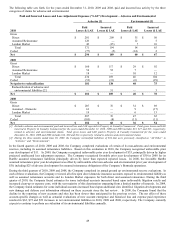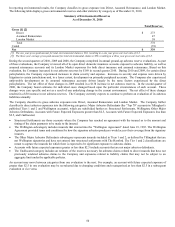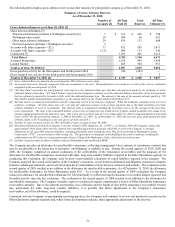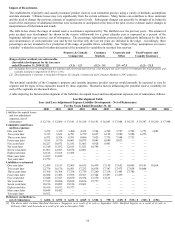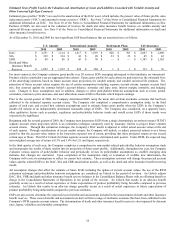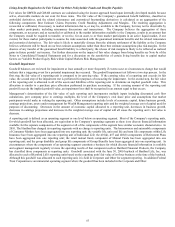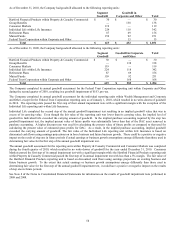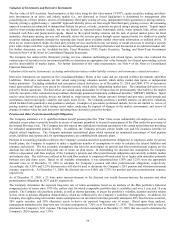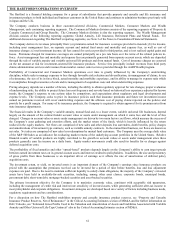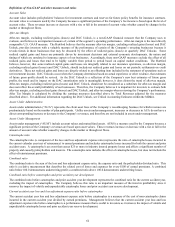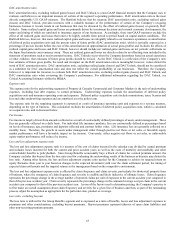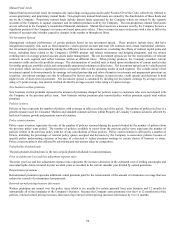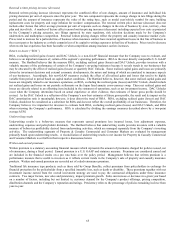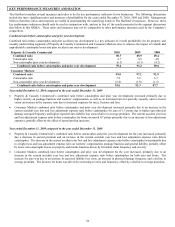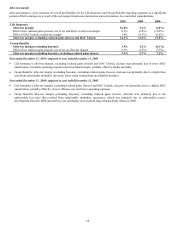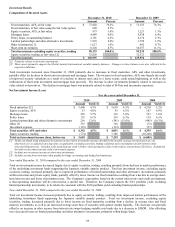The Hartford 2010 Annual Report Download - page 59
Download and view the complete annual report
Please find page 59 of the 2010 The Hartford annual report below. You can navigate through the pages in the report by either clicking on the pages listed below, or by using the keyword search tool below to find specific information within the annual report. 59
Valuation of Investments and Derivative Instruments
The fair value of AFS securities, fixed maturities, at fair value using the fair value option (“FVO”), equity securities, trading, and short-
term investments in an active and orderly market (i.e., not distressed or forced liquidation) is determined by management after
considering one of three primary sources of information: third-party pricing services, independent broker quotations or pricing matrices.
Security pricing is applied using a “waterfall” approach whereby prices are first sought from third-party pricing services, the remaining
unpriced securities are submitted to independent brokers for prices, or lastly, securities are priced using a pricing matrix. Typical inputs
used by these pricing methods include, but are not limited to, reported trades, benchmark yields, issuer spreads, bids, offers, and/or
estimated cash flows and prepayments speeds. Based on the typical trading volumes and the lack of quoted market prices for fixed
maturities, third-party pricing services will normally derive the security prices through recent reported trades for identical or similar
securities making adjustments through the reporting date based upon available market observable information as outlined above. If
there are no recent reported trades, the third party pricing services and brokers may use matrix or model processes to develop a security
price where future cash flow expectations are developed based upon collateral performance and discounted at an estimated market rate.
For further discussion, see the Available-for-Sale, Fixed Maturities, FVO, Equity Securities, Trading, and Short-Term Investments
Section in Note 4 of the Notes to Consolidated Financial Statements.
The Company has analyzed the third-party pricing services valuation methodologies and related inputs, and has also evaluated the
various types of securities in its investment portfolio to determine an appropriate fair value hierarchy level based upon trading activity
and the observability of market inputs. For further discussion of fair value measurement, see Note 4 of the Notes to Consolidated
Financial Statements.
Valuation of Derivative Instruments, excluding embedded derivatives within liability contracts and reinsurance related derivatives
Derivative instruments are reported on the Consolidated Balance Sheets at fair value and are reported in Other Investments and Other
Liabilities. Derivative instruments are fair valued using pricing valuation models, which utilize market data inputs or independent
broker quotations. Excluding embedded and reinsurance related derivatives, as of December 31, 2010 and 2009, 97% of derivatives
based upon notional values, were priced by valuation models, which utilize independent market data. The remaining derivatives were
priced by broker quotations. The derivatives are valued using mid-market level inputs that are predominantly observable in the market
with the exception of the customized swap contracts that hedge guaranteed minimum withdrawal benefits (“GMWB”) liabilities. Inputs
used to value derivatives include, but are not limited to, swap interest rates, foreign currency forward and spot rates, credit spreads and
correlations, interest and equity volatility and equity index levels. The Company performs a monthly analysis on derivative valuations
which includes both quantitative and qualitative analysis. Examples of procedures performed include, but are not limited to, review of
pricing statistics and trends, back testing recent trades, analyzing the impacts of changes in the market environment, and review of
changes in market value for each derivative including those derivatives priced by brokers.
Pension and Other Postretirement Benefit Obligations
The Company maintains a U.S. qualified defined benefit pension plan (the “Plan”) that covers substantially all employees, as well as
unfunded excess plans to provide benefits in excess of amounts permitted to be paid to participants of the Plan under the provisions of
the Internal Revenue Code. The Company has also entered into individual retirement agreements with certain retired directors providing
for unfunded supplemental pension benefits. In addition, the Company provides certain health care and life insurance benefits for
eligible retired employees. The Company maintains international plans which represent an immaterial percentage of total pension
assets, liabilities and expense and, for reporting purposes, are combined with domestic plans.
Pursuant to accounting principles related to the Company’ s pension and other postretirement obligations to employees under its various
benefit plans, the Company is required to make a significant number of assumptions in order to calculate the related liabilities and
expenses each period. The two economic assumptions that have the most impact on pension and other postretirement expense are the
discount rate and the expected long-term rate of return on plan assets. In determining the discount rate assumption, the Company
utilizes a discounted cash flow analysis of the Company’ s pension and other postretirement obligations and currently available market
and industry data. The yield curve utilized in the cash flow analysis is comprised of bonds rated Aa or higher with maturities primarily
between zero and thirty years. Based on all available information, it was determined that 5.50% and 5.25% were the appropriate
discount rates as of December 31, 2010 to calculate the Company’ s pension and other postretirement obligations, respectively.
Accordingly, the 5.50% and 5.25% discount rates will also be used to determine the Company’ s 2011 pension and other postretirement
expense, respectively. At December 31, 2009, the discount rate was 6.00% and 5.75% for pension and other postretirement expense,
respectively.
As of December 31, 2010, a 25 basis point increase/decrease in the discount rate would decrease/increase the pension and other
postretirement obligations by $137 and $9, respectively.
The Company determines the expected long-term rate of return assumption based on an analysis of the Plan portfolio’ s historical
compound rates of return since 1979 (the earliest date for which comparable portfolio data is available) and over 5 year and 10 year
periods. The Company selected these periods, as well as shorter durations, to assess the portfolio’ s volatility, duration and total returns
as they relate to pension obligation characteristics, which are influenced by the Company’ s workforce demographics. In addition, the
Company also applies long-term market return assumptions to an investment mix that generally anticipates 60% fixed income securities,
20% equity securities and 20% alternative assets to derive an expected long-term rate of return. Based upon these analyses,
management maintained the long-term rate of return assumption at 7.30% as of December 31, 2010. This assumption will be used to
determine the Company’ s 2011 expense. The long-term rate of return assumption at December 31, 2009, that was used to determine the
Company’ s 2010 expense, was 7.30%.


